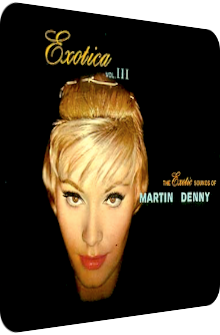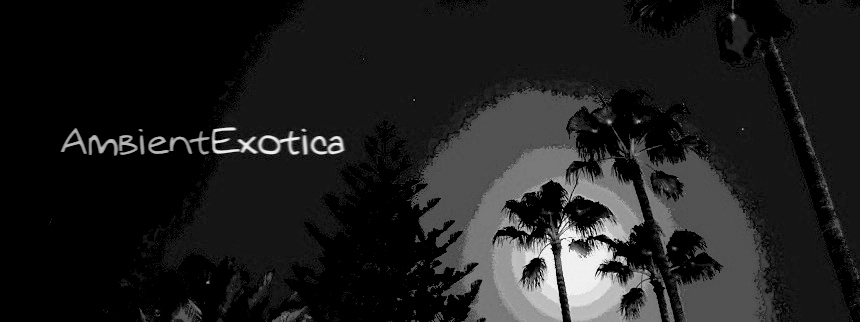
Martin Denny
Exotica Volume III
1959
It is hard to lobby for albums whose titles lack inspiration and are seemingly jejune, but Exotica Volume III by pianist, composer and kickstarter Martin Denny (1911–2005) is no such bland work despite its creepy Roman numerals at the end which make it seem like an also-ran in a series of compilations rather than a gold standard that lives up to the promise of its very genre. The arrangements are anything but paradisal, beautiful and tropical.
Released in 1959 on Liberty Records, the reason of christening the album Exotica Volume III is both curious and understandable. It is curious due to the crystal clear establishment of the Exotica genre in the heads – and hearts – of Denny’s growing contemporary fanbase whose interest peaks around 1959 and sees grand openings of tiki bars and temples all over North America. Martin Denny has already released approximately ten albums at the time, everyone knows the style he and his bandmates stands for. From this viewpoint, a title like Exotica Volume III is an affront. Marketing-wise, however, it is a clever bait to capture the few last remaining lost souls who have heard about the genre, but did not yet have their interest kindled.
After the original Exotica and Denny’s third album Exotica Volume II (both released in 1957), the third volume draws from a wide range of styles and is pieced together by six unmentioned principal columns, but more about them at the end of the review. Martin Denny on the piano is joined by Julius Wechter on multitudinous mallet instruments, August “Augie” Colón on many exotic drums and Harvey Ragsdale on the double bass. Colón reprises his role as the birdcaller extraordinaire, and indeed, there are birdcalls and animal noises aplenty on this album, or else it would not deserve its title. Ten exotic renditions and two original cuts are featured. Is Exotica Volume III the best one of the triptych?
The album opens with a gorgeous take of Les Baxter’s Jungle River Boat. Baxter’s orchestra string-fueled compositions do not necessarily keep all of their magic during their Jazz quartet-friendly transformation process, but what they lose in density and Space-Age vigor, they gain in exoticism. Martin Denny’s rendition is a delight, much gentler and somehow closer to the depicted scenery. Right from the get-go, the polyphony of the bandleader’s piano and Julius Wechter’s glistening vibraphone evoke an aqueous riverbed whose adjacent shrubbery is epitomized by Augie Colón’s birdcalls and bongos. Frizzling maracas and Wechter’s use of the xylophone during the lead melody boost the tropical dimension. A Bossa Nova or Cha Cha Cha at its core due to the archetypically creaking guiro, Denny’s arrangement remains wonderfully focused. The birdcalls might be enormously varied, but the instrumental pool does not grow out of proportion. It is all about the synergy and simultaneity of the instruments. The result is enormously genteel and poetic.
The jungle river leads to a harbor at night: Gordon & Jimmy Kennedy‘s and Hugh Williams’ Harbor Lights opens with a wonderful field recording of dabbling water. The duality of distantly Far Eastern tone sequences and a nightly mystique only lasts for a moment. The following mood range is much more gentle, with glitzy glockenspiels, slow piano spirals and the reoccurring sound of a ship’s signal altogether painting an ambience that is ever-soothing. Harvey Ragsdale’s droning double bass feels like a quiet breeze. A fleeting visit that feels much longer than its actual duration suggests.
Martin Denny’s own Manila follows, and it is one of these unique Exotica tunes that have garnered the status of a classic. The melody on the piano and vibe is catchy, oscillating between a carefree melancholia and transfiguring glimpses of paradise. Colón’s bongos and congas are placed upfront and are gentle enough to not augment the energy level all too much, even though the beat structure is notably multi-faceted. Denny’s original is superb, but even better is the gargantuan version of The Waitiki 7 off their album Adventures In Paradise (2009); seven minutes of pure bliss plus new segues await the listener.
But let me go back to Exotica Volume III and one of its most curious inclusions, namely Eddie Lund’s and Yves Roche’s Mama Iti E Papa E. Denny’s crew turns the military march structure into a bucolic blast. Rapidly firing and ultra-dense percussion layers of the sizzling kind almost swallow the syrupy vibraphone polka dots, piano chords and warbled vibrato of the flute. The middle section sees the percussion prowess decrease and allows the listener to feast on the xylophone glints. The melody has not aged all too well and is too schmaltzy, but the percussion thicket alone makes this a vibrant tune. If this was the closer, I would not have been surprised in the slightest, for it continues the humorous and military march-related tendencies of Denny’s 50’s works.
While the pianist’s own Bamboo Lullaby is a clear cut vintage Exotica piece of the bubbling downtempo kind and loaded with ever-vesiculating shell percussion, marimba droplets, rhythm xylophones and glockenspiel goodness, the magnificent Ringo Oiwake, originally written by Fujio Ozawa and Masao Yoneyama in 1952, is a truthfully Japanese piece awash with dusky twilight and made famous by Arthur Lyman’s take on his exotic debut Taboo (1957). Denny adds sanguine guitar chords to the gong-accentuated hi-tom placenta. The melody is played by Wechter on his vibraphone, wind chimes expand the mystique. Best of all is the jazzy intermission which ventures into an easygoing bachelor pad location before the return to the arcaneness of the original. Ringo Oiwake is simply a stunning piece, and Denny’s version is just the tip of the iceberg, for Paul Mark’s koto-infused organ version on East To West (1961) is even closer to the spirits of the Japanese original. Meanwhile, fans of symphonic works will enjoy Werner Müller‘s aka Ricardo Santos’ energetic eruption on Holiday In Japan (1958). The base frame of Ringo Oiwake allows numerous interpretations, and I for one am always curious about the level of seriousness and surrounding darkness in the respective rendition.
Side B leaves the crepuscular clime of Ringo Oiwake behind and launches with Alfred Newman’s and Frank Loesser’s Exotica opus Moon Of Manakoora. The prelude proves to be fantastic, the synergy of the vibes, guitar and piano is super-languorous, but the arrangement continues to shine and emanates a nocturnal ambiance that is anything but mellow. Augie Colón’s nightbird impressions, his gently beaten boo-bams as well as the translucent glockenspiels are phantasmagoric, each instrument’s decay illuminates the null space and coats it in an ashen light. Philip Braham’s and Douglas Furber’s Limehouse Blues then returns to Far Eastern lands with gamelan gongs, pentatonic xylophone-glockenspiel couples, galloping hi-toms and the gelid glitters of wind chimes. The piano base is designedly muffled. I am not too fond of this take, as it is too pointillistic, but the shadier aura is a great counteroffensive against a derogatory listener’s degradation of this album as an Easy Listening artifact.
Charles E. King’s and Mary Jane Montano’s Beautiful Kahana is exactly that. In the hands of Martin Denny, the beauty is astutely carved out via its ambient physiognomy. Rather than placing a definite rhythm below the iridescent blebs and specks, it is only Ragsdale’s double bass and a few bamboo rods and bongos that figuratively float in the very fluxion of multitudinous textures. There is always something glowing or glinting throughout the runtime, be it wind chimes, birdcalls or the fantastic elevation of the rising chord structure, with each tercet emanating an ever-increasing sense of adventure and rapture. Beautiful Kahana is that kind of music I named this website after: AmbientExotica.
To the desert! Denny’s take on Duke Ellington’s Caravan showcases something that is often amiss in the various other interpretations out there, and that is the feeling of being part of said caravan. Clinging tambourines and shell percussion as well as bongos create a sense of order and discipline, although the group does not maintain this groove for too long but unleashes improvised Japanese tonalities that are ot part of the original before returning back to the enigmatic arabesques of the desert. Another great twist is Augie Colón’s percussion solo.
Up next is Congo Train, both a take on Les Baxter’s composition and a foil to Martin Denny’s Burma Train off Primitiva (1958). As expected, warped flutes mimic a train whistle, shuffling shakers copy the crossed railway, but what outshines this admittedly important complexion is Julius Wechter’s labyrinthine yet pristine vibraphone billows which add a jazzy theme to the tune. His marimba tones are equally warm and good-spirited. Constant birdcalls accompany the traveler and turn out to be the last instance of their appearance, as the outro Hello, Young Lovers by Richard Rodgers and Oscar Hammerstein II is a Japan-oriented closure to the third Exotica volume complete with the typical pentatonic harmonies on all involved mallet instruments. The rhizomes of the piano backing are the only Occidental remainders, everything else is lit by the rising sun. Best of all: the group denies the Romantic overtone of the original and creates a polymorphous Exotica tune of soothing aortas and a mellifluous circumambience.
Exotica Volume III may be the last installment of Martin Denny’s Exotica triptych, but it is of course closely related to its preceding and subsequent brethren. The reason for adding the Roman numerals to the album title is naturally driven by the fact that this is part of a series and in order to make derogatory listeners – who at some point have heard about the genre – aware of this record, sure, but in terms of the aesthetic reason and without overanalyzing the background of the naming invention, I think that the Martin Denny Group wants to showcase the whole stylistic range of the genre, at least in the given Jazz setting. Martin Denny has either delivered some seriously focused works or albums whose titles do not necessarily relate to the majority of the presented material. Exotica Volume III is a convenient title, a benchmark of faux-Oriental and genuine Far Eastern material as well as exotified orchestra classics, interpretations of already exotic tunes and completely new inventions. These six stylistic choices are the carrying columns of the album.
If the Exotica fan can get over the boring album title – and the reused cover which was photographed during the same session as the one on 1959’s Afro-Desia – it is time to bathe in its stunning presentation. Les Baxter’s Jungle River Boat works fantastically well when played by a quartet, Martin Denny’s own Manila is a nostalgic Exotica classic, Ringo Oiwake bases on the contemplative darkness of the original and ennobles it with Asian percussion instruments, and the proto-Ambient versions of Moon Of Manakoora and Beautiful Kahana shimmer in pastel colors to this day and have not lost even one particle of their magic. There is no great story to tell regarding its overarching style or reason of existence: Exotica Volume III offers, as the old saying goes, “more of the same,” but I would like the reader to distill the positive connotation of this ancient wisdom. The huge amount of birdcalls, the particularly big braiding of mallet instruments as well as the percussion scheme and the coupling of instruments in order to unleash blissful flashes of polyphony make this last volume a no-brainer. The material is simply too good to avoid.
Exotica Review 300: Martin Denny – Exotica Volume III (1959). Originally published on Jan. 4, 2014 at AmbientExotica.com.
